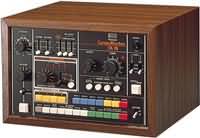
Roland Corporation is a Japanese manufacturer of electronic musical instruments, electronic equipment and software. It was founded by Ikutaro Kakehashi in Osaka on April 18, 1972. In 2005, Roland's headquarters relocated to Hamamatsu in Shizuoka Prefecture. It has factories in Malaysia, Taiwan, Japan, and the USA. As of March 31, 2010, it employed 2,699 people. In 2014, Roland was subject to a management buyout by Roland's CEO Junichi Miki, supported by Taiyo Pacific Partners.

A drum machine is an electronic musical instrument that creates percussion sounds, drum beats, and patterns. Drum machines may imitate drum kits or other percussion instruments, or produce unique sounds, such as synthesized electronic tones. A drum machine often has pre-programmed beats and patterns for popular genres and styles, such as pop music, rock music, and dance music. Most modern drum machines made in the 2010s and 2020s also allow users to program their own rhythms and beats. Drum machines may create sounds using analog synthesis or play prerecorded samples.

The Roland TR-808 Rhythm Composer, commonly known as the 808, is a drum machine manufactured by the Roland Corporation between 1980 and 1983. It was one of the first drum machines to allow users to program rhythms instead of using preset patterns. Unlike its nearest competitor at the time, the more expensive Linn LM-1, the 808 generates sounds using analog synthesis rather than by playing samples.

The Roland TR-909 Rhythm Composer is a drum machine introduced by the Roland Corporation in 1983. It succeeded the TR-808, and was the first Roland drum machine to use samples for some sounds. It was also the first Roland drum machine with MIDI functionality, allowing it to synchronize with other devices. Though it was a commercial failure, the 909 became influential in the development of electronic dance music genres such as techno, house and acid.
Boss is a manufacturer of effects pedals for electric guitar and bass guitar. It is a division of the Roland Corporation, a Japanese manufacturer that specializes in musical equipment and accessories. For many years Boss has manufactured a wide range of products related to effects processing for guitars, including "compact" and "twin" effects pedals, multi-effect pedals, electronic tuners and pedal boards. In more recent times, Boss expanded their product range by including digital studios, rhythm machines, samplers and other electronic music equipment. They also are now manufacturing solid-state amplifiers and speaker heads such as the Waza and the Katana. Both feature multi-effects units meant to emulate Boss' classic effects pedals.

The Roland SH-1000, introduced in 1973, was the first compact synthesizer produced in Japan, and the first synthesizer produced by Roland. It resembles a home organ more than a commercial synth, with coloured tabs labelled with descriptions of its presets and of the "footage" of the divide-down oscillator system used in its manually editable synthesizer section. It produced electronic sounds that many professional musicians sought after whilst being easier to obtain and transport than its Western equivalents.

The Roland MC-303 is the first of a series of musical instruments known as a Groovebox. It combines a simple sound module with a sequencer to record and store notation, along with controls aimed at encouraging the musician to improvise the music while it is playing. Despite the number in its name and the attention it received at its launch, the MC-303 has more in common with other MC prefixed synthesizers, which contain built-in sequencers, than it does with the famous Roland TB-303. As the first Groovebox, the MC-303 was the first in a line of inexpensive products specifically targeted towards house DJs and amateur home musicians rather than professional producers. It was superseded by the Roland MC-505. It is the predecessor to the Roland JX-305, Roland D2, Roland MC-307, Roland EG-101, Roland MC-09, Roland MC-909, Roland MC-808, and most recently the Roland MC-707 in 2019, along with its more portable sibling, the Roland MC-101.
Ikutaro Kakehashi, also known by the nickname Taro, was a Japanese engineer, inventor and entrepreneur. He founded the musical instrument manufacturers Ace Tone, Roland Corporation, and Boss Corporation, and the audiovisual electronics company ATV Corporation.

The Roland MC-505 is a groovebox conceived in 1998 as a combination of a MIDI controller, a music sequencer , a drum machine, and a desktop synthesizer with many synthesis features: arpeggiator, oscillators, and voltage-controlled filter, control of attack, decay, sustain and release, different envelopes and 2 Lfo. It was released as the successor to the Roland MC-303 and is a compact version of the Roland JX-305 Groovesynth without the full set of 61 keys. It is also the predecessor to the Roland D2, Roland MC-307, Roland MC-909 and the Roland MC-808.
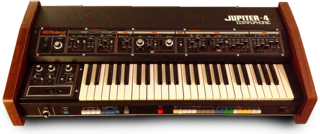
The Roland Jupiter-4 (JP-4) was an analog synthesizer manufactured by the Roland Corporation between 1978 and 1981. It was notable as the company's first self-contained polyphonic synthesizer, and for containing digital control of analog circuits, allowing for such features as programmable memories and voice assignment modes.

The discontinued Roland MC-909 Sampling Groovebox combines the features of a synthesizer, sequencer, and sampler, with extensive hands-on control of both the sound engine and the sequencing flow. It was intended primarily for live performance of pre-programmed patterns consisting of up to 16 tracks of MIDI data. It was released by Roland Corporation on October 8, 2002. This product was announced at the AES Fall Convention in 2002. It is the direct successor to the Roland MC-505 and is the predecessor to the Roland MC-808. Which eventually ended the "Groovebox by year 2010" line of products by Roland which began in the year 1996 with the Original Roland MC-303 groovebox. The Roland Groovebox began again resurgence in the year 2019 with a two new modern & redesign Roland MC-707 GROOVEBOX/Roland MC-101 GROOVEBOX. The Roland MC-909 was developed from the blueprint of Roland's own "Roland Fantom-S Workstation & Roland Fantom-X Workstation" and uses the same structure and operating system, with some differences regarding the Patterns section, not implemented in the Roland Fantom S/X6/X7/X8 Workstation.
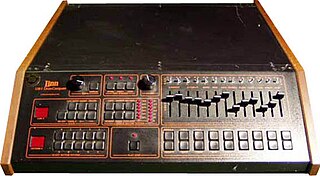
The Linn LM-1 Drum Computer is a drum machine manufactured by Linn Electronics and released in 1980. It was the first drum machine to use samples of acoustic drums, and one of the first programmable drum machines. Its designer, the American engineer Roger Linn, wanted a machine that would produce more realistic drum sounds and offer more than preset patterns.
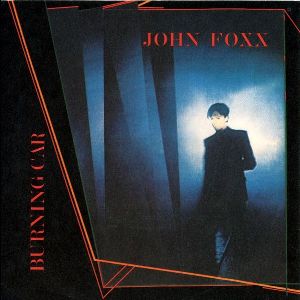
"Burning Car" is a song by John Foxx, released as a single in 1980. It was his third solo single, following "Underpass" and "No-One Driving" earlier in the year. The track was not included on Foxx's debut solo album Metamatic, post-dating its January 1980 release, but has been included as a bonus track on the 2001 and 2007 CD reissues. It was Foxx's last 1980s record in a hard-edged electronica style.

"Bombers" is the second single by Tubeway Army, released in 1978.
The Doctor Rhythm DR-110 Graphic is a drum machine introduced in 1983 by the Boss product division of the Japanese Roland Corporation. It was the second entry in their DR series, following up on the much simpler DR-55.
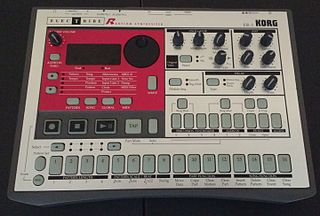
The Korg Electribe R was released in 1999 as a dedicated electronic drum machine to complement the Korg Electribe A bass synthesizer. It features a 64 step sequencer and is MIDI-controllable. The sound is generated by digital signal processor circuits but can be manipulated in realtime. A cross modulation function can be applied to percussion synthesizers 1 and 2 in the ER-1 Mk II version. The only other differences were new preset rhythm patterns and the metal casing. Because of the easy programming possibilities and competitive pricing the ER-1 quickly became popular among DJs and studio musicians. The overall sound character can be described as, although synthetic, similar to classic analog drum machines. However, the sound remains completely "tweakable" allowing realtime human variation and interaction, not unlike 4 simultaneous percussion synthesizers. In 2010, Korg released iElectribe R, a software version of the Electribe R for the iPad.

A synthesizer is an electronic musical instrument that generates audio signals. Synthesizers typically create sounds by generating waveforms, through methods including subtractive synthesis, additive synthesis and frequency modulation synthesis. These sounds may be altered by components such as filters, which cut or boost frequencies; envelopes, which control articulation, or how notes begin and end; and low-frequency oscillators, which modulate parameters such as pitch, volume, or filter characteristics affecting timbre. Synthesizers are typically played with keyboards or controlled by sequencers, software or other instruments, and may be synchronized to other equipment via MIDI.

The Sirius is a keyboard "groove-synth," featuring a subtractive hybrid-tone-generation synthesizer referred to as DTE synthesis introduced in 1997 by Quasimidi. The unit featured both real-time and step sequencers with pattern- and song-modes, capable of acting basic drum machine, groove-box, or sound-module.
The Mini Pops were a number of early drum machines from the Japanese musical equipment company Korg during the late 1960s and the 1970s. The machines were based around a number of preset rhythm patterns, such as waltz, samba and rhumba.
